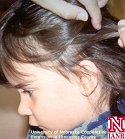Screening is your best defense to finding and eliminating a head lice infestation. The sooner you confirm an infestation the easier it is to deal with. The fewer eggs to remove, the easier the work load is. We recommend weekly checks; make it part of your regular hygiene routine.
The simplest way to confirm an infestation is by finding lice eggs (nits). Nits are cemented to the hair shaft and are difficult to remove, unlike the live lice which can detect movement or light and quickly crawl away and hide.
Start by getting a good light, a magnifying visor and two screening sticks.
Use the sticks to part and separate the hair so you can see easily to the root of the hair shaft. Look for tiny, tan coloured, smooth oval shaped eggs(nits).
Nits are always cemented to one side of the hair shaft and are usually found close to the root. The female louse lays her eggs in groupings of 8 to 10 so if you spot a nit, look for more nits in the same general area.
Run your fingers along the hair shaft to see if you can easily move the suspected nit. If it truly is a nit it will not slip or fall off the hair shaft. If it does move, it most likely is not a nit as nits need to be pulled off the hair shaft with your finger nails or a good lice comb. They are difficult to remove.
Work your way around the head separating the hair and having a close look. Focus on the Hot Spots, these are the warmest areas on the head. Behind the ears at the nape of the neck and on the crown of the head, are where the female lice likes to lay her eggs.
Finally have a good look throughout all the hair. If you want to know if there are any live lice present, the Wet-Combing Method is the best method to screen for live lice. Wet-Combing slows the live lice down which makes them easy to remove.
Have a look at our Head Lice Facts page to familiarize yourself with photos of lice and nits. If you’re still not sure what you are looking at, give us a call we can help you make a diagnosis over the phone or drop us an email.


